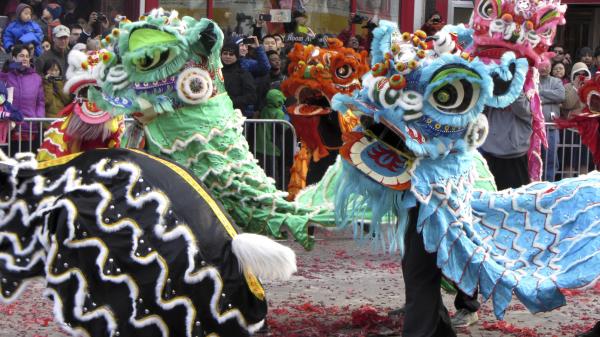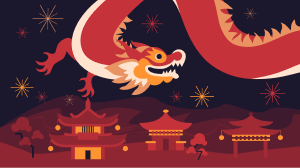The Chinese Calendar
China and many Chinese communities around the world use the Chinese calendar for traditional purposes.

Chinese lions dance to the firecrackers in Chinatown of Washington D.C. for the annual Chinese New Year celebration.
©iStockphoto.com/Coast-to-Coast
The Chinese calendar is a lunisolar calendar that is used to determine important festival dates, such as Lunar New Year.
Lunisolar Calendar
The Chinese calendar is lunisolar. It is based on exact astronomical observations of the Sun's longitude and the Moon's phases. It attempts to have its years coincide with the tropical year and shares some similarities with the Jewish calendar.
In both these calendars, a common year has 12 months and a leap year has 13 months; and an ordinary year has 353–355 days while a leap year has 383–385 days.
In Modern Society
Although the Chinese calendar originated in China, these days, the Gregorian calendar is used for civil purposes. However, the Chinese calendar is still observed among various Chinese communities around the world. It is used to determine festival dates, such as Lunar New Year, as well as auspicious dates, such as wedding dates. It is also used to determine Moon phases because it follows the Moon.
Counting the Years and the 60-Year Cycle
The Chinese calendar does not count years in an infinite sequence. Each year is assigned a name consisting of two components within each 60-year cycle. The first component is a celestial stem:
- Jia (associated with growing wood).
- Yi (associated with cut timber).
- Bing (associated with natural fire).
- Ding (associated with artificial fire).
- Wu (associated with earth).
- Ji (associated with earthenware).
- Geng (associated with metal).
- Xin (associated with wrought metal).
- Ren (associated with running water).
- Gui (associated with standing water).
The Chinese Zodiac
What's my Chinese Zodiac animal?
The second component is a terrestrial branch. It features the names of animals in a zodiac cycle consisting of 12 animals:
- Zi (Rat).
- Chou (Ox).
- Yin (Tiger).
- Mao (Rabbit).
- Chen (Dragon).
- Si (Snake).
- Wu (Horse).
- Wei (Sheep).
- Shen (Monkey).
- You (Rooster).
- Xu (Dog).
- Hai (Boar/pig).
Each of the two components is used sequentially. Therefore, the first year of the 60-year cycle becomes jia-zi, the second year is yi-chou, and so on. One starts from the beginning when the end of a component is reached. The 10th year is gui-you, the 11th year is jia-xu (restarting the celestial stem) the 12th year is yi-hai, and the 13th year is bing-zi (restarting the celestial branch). Finally, the 60th year is gui-hai.
This pattern of naming years within a 60-year cycle dates back about 2000 years. A similar naming of days and months is no longer used but the date name is still listed in calendars. It has been customary to number the 60-year cycle since 2637 BCE when the calendar was supposedly invented.
Calculating Chinese New Year
According to Helmer Aslaksen, of the National University of Singapore, there are two rules of thumb used to calculate the new year in the Chinese calendar. The first rule of thumb is that Chinese New Year should be the New Moon closest to the beginning of spring (in the Northern Hemisphere), known as Lìchūn. This rule is correct most of the time, but it can fail if Lìchūn falls close to halfway between two New Moons. For example, it failed in both 1985 and 2015. Chinese New Year will always fall between January 21 and February 21.
The second rule of thumb is that most of the time Chinese New Year will fall 11 (or sometimes 10 or 12) days earlier than the previous year, but if that means that the event would be outside of the Chinese New Year range of January 21 to February 21, a leap month must be added so Chinese New Year jumps 19 (or sometimes 18) days later.
Leap Years
| Chinese Year (AH) | Start Date | Leap Year? |
|---|---|---|
| 4720 | Jan 22, 2023 | Yes |
| 4721 | Feb 10, 2024 | No |
| 4722 | Jan 29, 2025 | Yes |
| 4723 | Feb 17, 2026 | No |
| 4724 | Feb 6, 2027 | No |
The Chinese calendar features 12 months. However, an extra month is inserted in the calendar when a leap year occurs. Therefore, leap years in the Chinese calendar have 13 months, unlike leap years in the Gregorian calendar in which an extra day is included. A leap month is added to the Chinese calendar approximately every three years (7 times in 19 years). The name of the leap month is the same as the previous lunar month. A leap year in the Chinese calendar does not necessarily fall at the same time a leap year occurs in the Gregorian calendar.
One must calculate the number of New Moons between the 11th month in one year, which is the month with the December solstice, and the 11th month in the following year to figure out if a year is a leap year. The leap year must be inserted if there are 13 New Moons from the start of the 11th month in the first year to the start of the 11th month in the second year. At least one month does not contain a principal term (Zhongqi) in leap years. The solar term system has 12 principal terms to indicate the Sun's longitudes at every 30 degrees. The first month that does not have a principal term is determined as the leap month.
Calendar Background
The Chinese calendar's origins can be traced as far back as the 14th century BCE. The Shang oracle bones give evidence of a lunisolar calendar which has been much modified but persists to this day. It is believed that the Emperor Huangdi (Huang Ti or Huang Di) introduced the calendar between 3000 and 2600 BCE, or around 2637 BCE. It is also thought that his minister Ta Nao prepared the first calendar, called the Chia-tzu or Kan-chih system, which is translated as “the system of cyclical characters”.
Another phase was added to the calendar because the system was meant to be for popular use. Twelve animals were associated with each year during the Chou period. These 12 animals were commonly called the 12 Zodiac animals in western society. They were believed to be merely popular symbols and did not have any great significance. However, there have been various folktales linked the origin of the 12 animals.
China resisted the Gregorian calendar until 1912 but it was not widely used throughout the country until the Communist victory in 1949. This widespread change occurred on October 1, 1949, when Mao Zedong, who led the People's Republic of China, ordered that the year should be in accord with the Gregorian calendar.
Note: timeanddate.com wishes to thank various sources including Claus Tøndering, writer of Frequently Asked Questions about Calendars Version 2.8, and Helmer Aslaksen, of the National University of Singapore.
